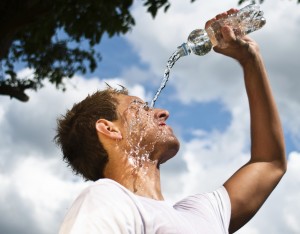Exercise and Heat Illness
by Hamid L. Sadri, DC, CCSP, ICSSD, CSCS, CKTP, CES, PES
 Exercise induced heat illness is a serious, and at times fatal, health risk facing athletes who train or compete during warmer times of the year. It is the third leading cause of death in the high school athletes in the United States. It is a condition that manifests when the body’s thermoregulatory systems are unable to properly maintain its core temperature causing it to rise to levels that can produce physical and mental symptoms, organ tissue damage, and death.As such, it is wise to be aware of this condition and to take proper steps to recognize and more importantly to prevent its occurrence. There are several stages of heat related illness and although each has some specific characteristics, they are not always easy to differentiate even by trained health professionals. The basic differentiating factor relates to the severity of the condition and is categorized as follows:
Exercise induced heat illness is a serious, and at times fatal, health risk facing athletes who train or compete during warmer times of the year. It is the third leading cause of death in the high school athletes in the United States. It is a condition that manifests when the body’s thermoregulatory systems are unable to properly maintain its core temperature causing it to rise to levels that can produce physical and mental symptoms, organ tissue damage, and death.As such, it is wise to be aware of this condition and to take proper steps to recognize and more importantly to prevent its occurrence. There are several stages of heat related illness and although each has some specific characteristics, they are not always easy to differentiate even by trained health professionals. The basic differentiating factor relates to the severity of the condition and is categorized as follows:
Types & Causes
1. Heat Cramps: Muscle cramps associated with exercise during hot weather characterized by involuntary and often painful twitching or spasm of skeletal muscles.Common areas affected are the abdomen, arms, and legs. This is usually caused by a loss of too much sodium during a bout of exercise. Athletes with a high sweat rate or those who find a salty residue on their skin or clothing after exercise are at a higher risk.An athlete suffering from heat cramps should be observed for other signs of heat illness.
2. Heat Syncope: Commonly known as “fainting”; Orthostatic Syncopal Episode is another form of heat illness.It is typically seen after “maximal-effort” exercise bouts while exposed to hot temperatures. This results in maximal dilation of the blood vessels supplying the skeletal muscles and subsequently a reduction of blood flow to the brain.Athletes who are not properly hydrated and those who do not go through a proper cool-down period after exercising are at a higher risk.
3. Heat Exhaustion: Technically known as Exertional Hyperthermia, is a state in which the athlete is unable to continue exercising in the heat. Losing large amounts of fluids and electrolytes (as is the common denominator in all heat-related illnesses) while performing strenuous physical activity in hot temperatures is the predisposing factor.It is divided into two categories: water-depletion (usually seen during a single bout of strenuous exercise in the heat) and salt-depletion. Typical symptoms include nausea, vomiting, headache, hyperventilation, hypotension and elevated heart rate accompanied by profuse sweating.If untreated, this stage can lead to circulatory collapse and heat stroke.
4. Heat Stroke: This is a true medical emergency and should be dealt with accordingly.The diagnosis is made when the body’s core temperature (this is taken rectally) rises above 104.9 degrees Fahrenheit. Typical symptoms include hot dry skin (although, not always), altered mental state (confused or irritable), lack of muscle control, vomiting, diarrhea, increased heart rate, hypotension, seizures and coma. The amount of damage and risk depends upon how high the core temperature reaches and how long it stays there.
Prevention and Management
Prevention of heat related illness begins with proper hydration, training, acclimatization and awareness of ambient temperature.Just as any other aspect of training, heat acclimatization follows the SAID (Specific Adaptation to Imposed Demand). For a trained athlete it typically takes a minimum of 2 weeks of training in hot temperatures for their body to learn how to properly regulate its temperature variances imposed by hot weather. For an untrained individual, or in highly humid weather this period may take as long as 2 to 3 months.
When considering the degree of risk involved for exercise and heat illness during exercise, special attention must be paid to not just the temperature, but rather ambient temperature, which also takes into account the degree of humidity. The best method of determining ambient temperature is the use of Wet Bulb Globe Temperature (WBGT). Although recommendations differ depending upon which source is used, on average, any day that the WBGT is above 82 degrees Fahrenheit should be considered high risk and outdoor exercise should be avoided or at least modified to limit risk of injury.
Training should follow the same regimen as in any other form of athletic preparation. The length and intensity of each exercise bout should be increased on a gradual basis with proper time being allowed for recovery. On days with higher ambient temperatures lower intensity and shorter duration events should be planned. During these high risk days it is necessary to take multiple breaks (preferably in a shaded area) from exercise.
Proper hydration is of utmost importance as research has shown that as little as 2 percent of body weight loss during exercise can predispose an athlete to exertional heat illness. Core body temperatures have shown to rise .25 to .35 degrees Fahrenheit for every percent of body weight loss during exercise. Since hydration needs are individualized and vary from one athlete to another, steps need to be taken to determine how an athlete must hydrate in order to avoid the risk of heat related illness.It must be kept in mind that dehydration can occur in a single bout of exercise or accumulatively over several days. One method to measure hydration needs is pre and post exercise weighing.For every pound lost during exercise, the athlete should have consumed 16 to 20 ounces of fluids.This may equate to drinking approximately 8 ounces of fluids every 20 minutes. The fluids taken should generally consist of a 50/50 mix of water and sports drinks. Additional electrolyte replenishment may be necessary in higher temperatures. Furthermore, an athlete must begin to hydrate for an exercise bout in higher temperature 2-3 days prior to the event. An easy method of self-regulating proper hydration is checking the color of one’s urine during exercise days. It should normally be a very light yellow color. If darker, it could indicate possible dehydration.
Management of heat illness follows some basic rules that apply to almost all levels of this injury. Keep in mind that heat stroke is a true medical emergency and the athlete must be treated by medical staff. Heat cramps can be the easiest to manage. Once activity ceases, the crams will generally subside.As for heat syncope and heat exhaustion, the athlete should be moved to a cool shaded area. Wet clothing should be replaced by dry ones. Ice packs can be placed on the forehead and under the armpits to help decrease body temperature. Both these stages may and often do require intravenous hydration. Vital signs should continuously be monitored paying special attention to body temperature, heart rate and blood pressure.
Following these simple steps can prevent very serious and possibly fatal injuries which can result from exercising in high temperatures.
Dr. Sadri has been practicing in Decatur, GA for 26 years and specializes in athletic injuries and rehab. The clinic, 1st Choice Sports Rehab Center, was named “The Best Sports Injury Center in the Southeast” by Competitor Magazine. To subscribe to our newsletter click here. To schedule an evaluation, call 404-377-0011.
Decatur Office
2545 Lawrenceville Hwy
Suite 100
Decatur, GA 30033
404-377-0011
Johns Creek Office
9810-B Medlock Bridge Rd
Suite 104
Johns Creek, GA 30097
404-300-9931
